Metawampe Monument
Introduction
Text-to-speech Audio
Images
Metawampe Monument & Statue, current location.
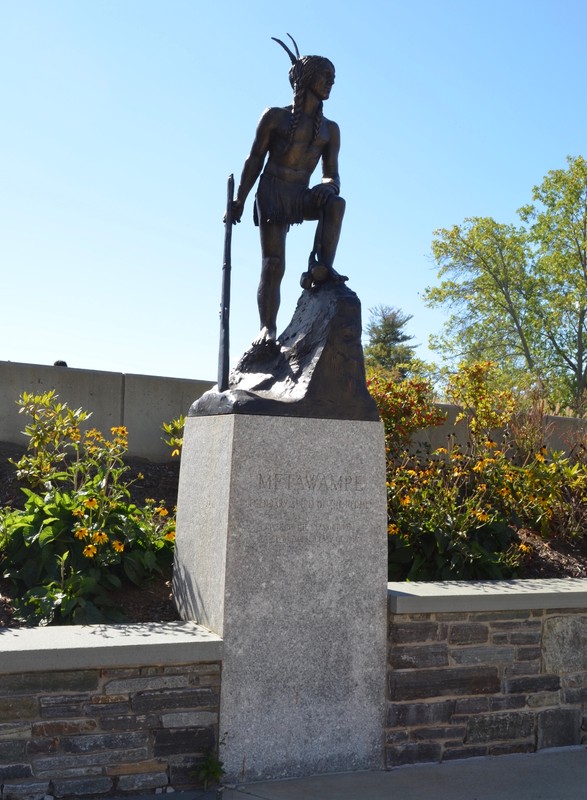
Metawampe, undated photograph.
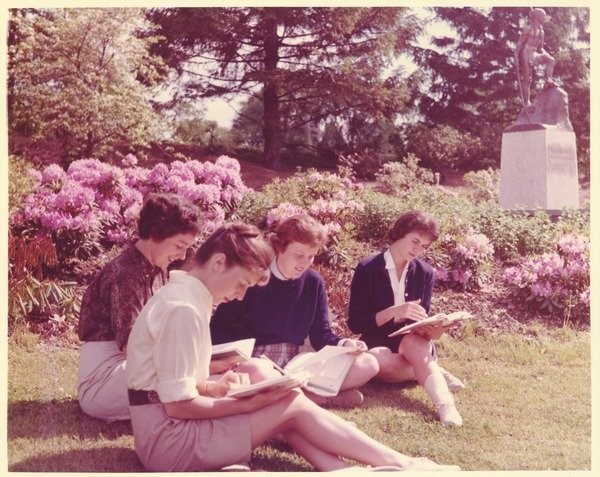
Raised fist logo placed on Metawampe statue, May 4, 1970.
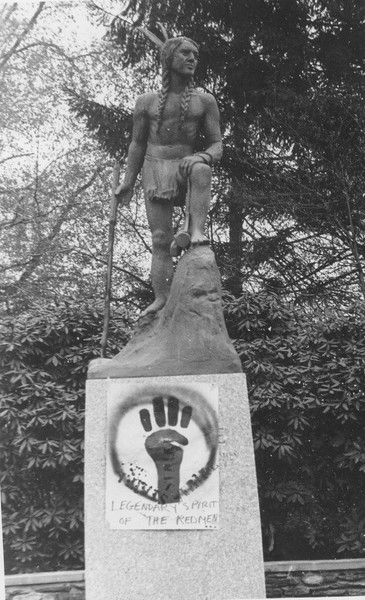
Ceremony on Metawampe lawn, ca. 1950. Faculty members in academic gowns walk past the podium during ceremonies on the lawn in front of the statue of Metawampe, a gift from the Class of 1950.
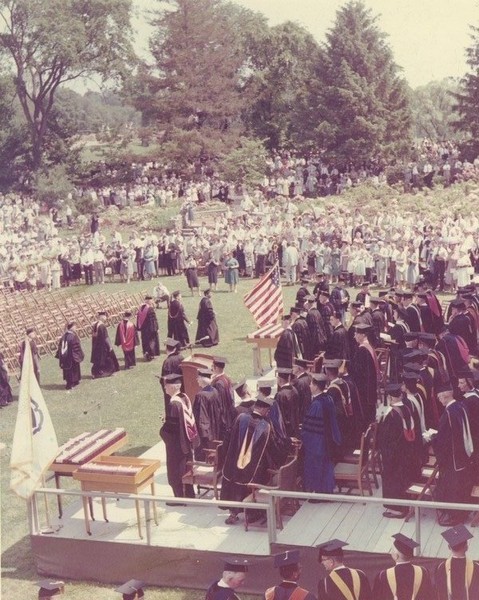
Robert Bertram in Native American headdress, ca. 1980. Robert E. "Bob" Bertram of the Class of 1949 wears a Native American headdress while standing with an unidentified man, also in Indian dress, at McGuirk Stadium. Photo titled "Metawampi".

Massachusetts Agricultural College Building Metawampe Club on Mt. Toby, ca. April 9, 1922.
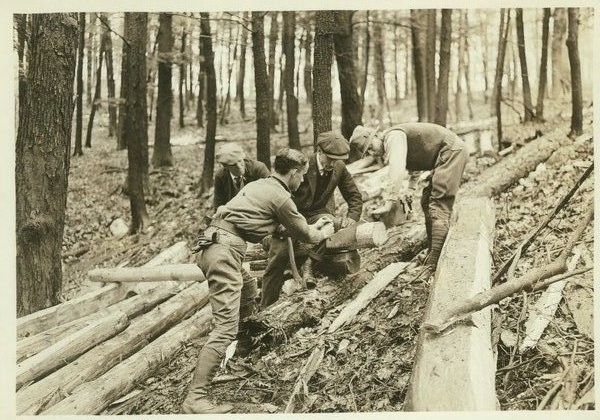
Backstory and Context
Text-to-speech Audio
Also See: Mascots
A number of nicknames and mascots have been associated over the years with the athletic teams of UMass Amherst and its predecessors Massachusetts Agricultural College and Massachusetts State College. As early as 1886, the football team at MAC was called the Statesmen, and although that name was never enthusiastically embraced – “Aggies” was sometimes substituted – it remained the most common name for teams use until 1948, being adopted as well by the College's all-male student quartet.
The Redmen
As the University grew in the years immediately following World War II, however, students began to agitate for what they saw as a more appropriate name for their teams. Spurred by the University's change in name from Massachusetts State College (for whom Statesmen seemed singularly appropriate) to the University of Massachusetts, George Burgess (Class of 1949) led a drive for a new nickname “as a first step in the rejuvenation of school spirit.” With varying degrees of sincerity, students proposed a range of alternative nicknames, from Aardvarks to Gnus, Tomahawks, Scarecrows, Pioneers, Yankees, Bulls, Pilgrims, Derelicts, Yo-yos, Petunias, and Bloody Red Raiders. The most popular names that emerged from the student body were apparently Minutemen, Redmen, Statesmen, Indians, and Mohawks, and at an all-campus referendum on Jan. 14, 1948, the matter was settled by a vote of 620 to 459. Proponents cited three reasons for the change from Statesmen to Redmen:
- “The courage, strength, resourcefulness, and charity of the Indians helped sustain the Plymouth settlement, which laid the foundation for subsequent settlements in what we now call Massachusetts.
- Traditionally Massachusetts has honored the Indian – the name of the Commonwealth itself is an Indian word. The Indian also appears on the seal of the Commonwealth.
- For centuries the Connecticut Valley was inhabited by the red man. With the aggrandizement of the Bay Colony's white population, the Indians showed strength and fierceness in defending his lands… a strength and fierceness well suited to a football team defending its goal posts.
The Minuteman
By 1966, however, the term Redmen began to come in for criticism as “not a fitting or proper name for the athletic teams of the University of Massachusetts.” A University Trustee, Gen. John J. Maginnis, argued that at UMass, the term Redmen was associated with the seventeenth century sachem Metawampe, about whom little was known, and had little specific emotional resonance for students: the name was an “unexciting, commonplace, lack-luster title with no eye or ear appeal,” he wrote. “It sounds no call.” Although Maginnis' proposal to change the name to Minutemen did not gain immediate traction, it would feed into a rising consciousness about the racist and sexist implications of Redmen.
On April 26, 1972, the Student Senate was presented with a resolution (S230) citing a “growing American consciousness deploring the perpetration of racist, sexist, and ethnic discrimination,” and arguing that it was imperative for the University to shed the Redman symbol for a “new school design.” Singled out for particular concern were the bathrooms in the Hatch (part of the Student Union), which were labeled “Braves” and “Squaws.” At Senate's final meeting of the year on May 3, the motion was amended with an additional proposal to change the teams' names to the W.A.S.P.s, with a logo of a wasp as mascot. “The amendment is not meant to be dilatory,” according to an explanation appended to the amendment, “nor is it an attempt to be fatuous; [the] move would spark publicity for the move and to call attention to discrimination and ethnic distortion on campus and elsewhere.” The Senate rejected the amendment on the grounds that students themselves should decide the logo, but approved the main motion.
While the Student Senate was considering the issues, the UMass Trustees forged ahead and voted to change the name of the mascot to the Minuteman, eliciting scarcely any response from the student body or alumni. According to the newly appointed Chancellor, Randolph W. Bromery, there was no outcry among the students or alumni one way or another, distracted, perhaps, by the end of the school year, the war in Vietnam, the impending Presidential elections, the fizzling of a two-day student strike, the Trustees' decision to suspend ROTC recruitment on campus, the antiwar occupation of Dickinson Hall, the string of protests at the Westover Air Force Base, and seemingly almost every other issue.
Despite the ready acceptance of the Minuteman, it too became the focus of controversy because of its symbolic associations. During the spring 1984, a referendum to change the name of the mascot was defeated by a margin of three to one, with Minuteman winning out over Artichokes and Statesmen. In the early 1990s, students revived the campaign opposing the Minuteman, citing it as a “symbol of oppression” and a reflection of racism, sexism, and militarism, or more simply, as a depiction of a white man with a gun. Chancellor David K. Scott announced that he was open to discussing the change, but a vocal backlash from supporters of the Minuteman in 1993-1994 and a change in opinion by some key opponents, who argued that they had come to accept the Minuteman as symbolic of liberation movements, eventually quelled the controversy.
References
- Daily Collegian, Sept. 25, 1947, Oct. 7, 1947, Jan. 8 and 16, 1948
- John J. Maginnis, Consideration of the following proposal by the Trustee Committee on Government and Unive4rsity Relations is hereby requested,” Dec. 16, 1966 (RG 1/6 Mascott Minutemen)
- John E. Burke memo to R. J. McCartney, Jan. 5, 1967. “Naming of University athletic teams” (RG 1/6)
- Student Senate Agenda and Minutes, April 26 and May 3, 1972. Student Senate Records (RG 45/1)
- Index for 1972
- Daily Collegian, Apr. 9, 1984; Oct. 13, 1993
